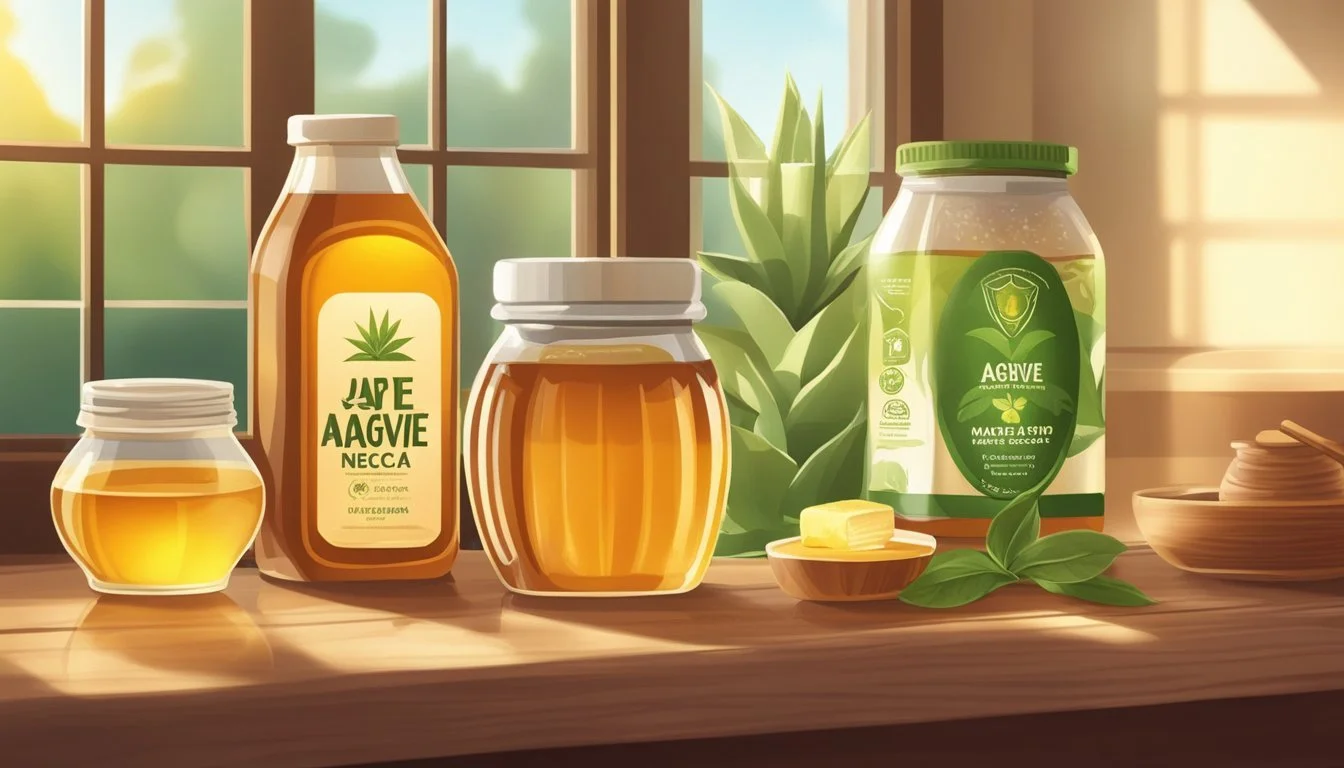Agave Nectar Substitutes
Top Alternatives for Sweetening Your Dishes
Agave nectar, a natural sweetener derived from the agave plant, is popular in various recipes for its mild flavor and liquid consistency. Its rise in use stems from its reputation as a healthier alternative to refined sugars, appealing to those looking to reduce their sugar intake or searching for vegan-friendly options. However, there are instances when one might need an alternative, whether due to availability, dietary preferences, or simply to experiment with different flavors and textures in cooking and baking.
Fortunately, there are several substitutes that can effectively replace agave nectar while maintaining the desired sweetness in dishes. Sweeteners like honey and maple syrup offer a similar profile in terms of consistency and are often preferred for their natural origins. On the other hand, corn syrup can provide a neutral-tasting sweetness, making it an ideal substitute in candy making. Each substitute comes with its own unique set of characteristics, and understanding how they interact with other ingredients is crucial to achieving the best results.
For those with dietary restrictions or specific health concerns, it is essential to consider how these alternatives compare to agave nectar in terms of glycemic index and caloric content. Substitutions may need to be adjusted proportionally, as the level of sweetness and moisture content can vary between sweeteners. Hence, the key to successful substitution lies in evaluating the unique properties of each sweetener and determining the most suitable one for the recipe at hand.
Understanding Agave Nectar
Agave nectar, also known as agave syrup, is a sweetener commercially produced from several species of agave plants. This section delves into the origins and production processes, its nutritional components, and the various culinary applications of agave nectar.
Origins and Production
The agave plant, which is native to Mexico, is the source of agave nectar. It primarily comes from the blue agave plant, which is also used in the production of tequila. Agave nectar is produced by extracting sap from the pina, or core, of the agave plant and then processing it into a syrup through heating. This process breaks down the natural carbohydrates into sugars, mainly fructose.
Nutritional Profile
Agave nectar is composed predominantly of fructose, which makes it considerably sweeter than regular sugar. While it provides few nutrients, it does contain small amounts of minerals such as potassium, calcium, and magnesium. Still, it is high in calories and should be used in moderation.
Nutrients Presence in Agave Nectar Fructose High (main component) Glucose Low Minerals Trace amounts (potassium, calcium, magnesium) Calories High (similar to sugar)
Culinary Uses
Agave nectar is versatile in the kitchen. It is a common sweetener in beverages and can be found in various healthy food products. Due to its high fructose content, it has a low glycemic index, which means it does not raise blood sugar levels as quickly as other sweeteners. It's often used in cooking and baking, as well as a topping for pancakes and waffles.
Reasons for Substituting Agave Nectar
In considering substitutes for agave nectar, individuals often factor in health implications, dietary constraints, and economic or accessibility concerns. These factors play essential roles in the decision-making process for those seeking alternative sweeteners.
Health Considerations
Agave nectar has a high fructose content and while it has a low glycemic index, it may affect blood sugar levels differently than other sweeteners. This is particularly crucial for individuals managing diabetes. Due to its calorie density and fructose level, some individuals may seek substitutes that have a lower impact on their blood sugar levels or overall calorie intake.
Dietary Restrictions
For those with dietary restrictions, finding the right sweetener is key. Vegan individuals might avoid certain sweeteners that are animal-derived. Although agave nectar is plant-based and suits a vegan diet, other reasons such as personal health goals or a preference for sweeteners with a lower glycemic index may guide their choices.
Availability and Cost
The accessibility of agave nectar can vary, and in some places, it might be more expensive or harder to find. Cost-effective alternatives may be more appealing for regular use, especially if they can be found easily in local stores. Substituting agave nectar with more readily available ingredients can make for a practical and economical choice.
Popular Agave Nectar Substitutes
When searching for agave nectar alternatives, one should consider natural sweeteners that match agave's sweetness and texture, with a focus on how these substitutes complement different recipes.
Honey and Maple Syrup
Honey is a commonly used natural sweetener that boasts a similar level of sweetness to agave nectar and has a slightly thicker consistency. It imparts a floral note and amber color, making it suitable for a range of dishes and drinks. Maple Syrup, another natural sweetener, offers a distinct flavor with hints of caramel that can enrich various recipes. Both honey and maple syrup can generally be substituted in a 1:1 ratio for agave nectar.
Coconut Nectar and Molasses
Coconut Nectar is known for its lower glycemic index and resembles the sweetness and color of agave nectar. It’s a fitting choice for those looking for alternative natural sweeteners. Molasses is darker in color with a more robust, caramel-like flavor. This high-mineral sweetener can contribute a rich depth to certain recipes and is particularly good in baked goods.
High-Fructose Corn Syrup and Simple Syrup
High-Fructose Corn Syrup (HFCS), widely used in the commercial food industry, mimics the sweetness level of agave nectar. While the consistency is similar, HFCS often has more calories. Alternatively, Simple Syrup, which is a combination of water and white sugar, can be custom-made to desired thickness and sweetness, making it a versatile option for various culinary applications.
Brown Rice Syrup and Golden Syrup
Brown Rice Syrup offers a nuttier, butterscotch-like flavor with a similar level of sweetness to agave nectar. It can be used in recipes where its distinct flavor complements the dish. Golden Syrup, known for its buttery taste and golden color, brings a special touch to recipes requiring a light treacle flavor and can provide the sweetness and sheen similar to agave nectar.
Substitutes in Specific Applications
Selecting the appropriate substitute for agave nectar in cooking and baking requires attention to flavor and consistency. Each application can benefit from different sweeteners to replicate or complement the properties of agave nectar.
Baking and Desserts
For baking, consistent moisture and sweetness are vital. Honey serves as a direct substitute and maintains the required moisture in cakes, cookies, and other baked goods. Maple syrup can also be used, offering a unique flavor profile particularly well-suited for items like pancakes and waffles. When using granulated sugar, one should add an additional half cup of liquid (such as water or milk) per cup of sugar to compensate for dryness.
Sweetener Measurement Additional Liquid Needed Honey 1:1 None Maple Syrup 1:1 None Granulated Sugar 1:1 1/2 cup per cup of sugar
For candy, switching to corn syrup is recommended due to its ability to prevent sugar crystallization, vital for the texture of sweets.
Beverages and Cocktails
When sweetening beverages or cocktails like a margarita or smoothie, the goal is to balance sweetness with fluidity. Simple syrup follows a one-to-one ratio and dissolves well. For a margarita, use simple syrup or granulated sugar, considering the need to dissolve it thoroughly. Honey or maple syrup also blends seamlessly into tea and coffee.
Beverage Type Suggested Sweetener Margaritas Simple Syrup or Granulated Sugar Smoothies Honey or Maple Syrup Tea & Coffee Honey or Maple Syrup
Sauces and Dressings
In sauces and dressings, the sweetener's impact on texture and flavor is crucial. Both honey and brown rice syrup will offer a balance akin to agave nectar's contribution, without overwhelming other flavors in salad dressings. They merge well with both tangy and savory components.
Sauce/Dressing Type Recommended Sweetener Salad Dressings Honey or Brown Rice Syrup
Understanding Sweetness and Consistency
When substituting agave nectar, it's important to consider how sweetness levels and consistency affect the final product.
Comparing Sweetness Levels
Agave nectar is known for its relatively mild sweetness. Substitutes like molasses and amber corn syrup provide a similar sweetness but with a deeper, more caramel-like aftertaste. Honey, while comparable in sweetness, adds a floral note. Golden syrup offers rich, buttery notes and is slightly less sweet than agave nectar.
Impact on Texture and Consistency
Consistency is another critical factor. Agave nectar has a syrupy texture; substitutes must match this to prevent altering the dish's final texture. Brown rice syrup and light corn syrup mimic the mild taste and similar syrupy consistency of agave nectar. Honey tends to have a thicker consistency, which may need to be considered when measuring for an exact replacement.
Health-Focused Alternatives
When seeking to replace agave nectar in a diet, health-conscious consumers often gravitate toward alternatives that offer low-calorie options or ones that can provide additional nutritional benefits. This section explores sweeteners that are not only substitutes for agave nectar but also align with a health-focused approach.
Low-Calorie and Natural Options
For individuals monitoring their caloric intake, low-calorie natural sweeteners serve as apt replacements. Here are some notable choices:
Stevia: A zero-calorie sweetener derived from the leaves of the Stevia rebaudiana plant, known for its potency and lower glycemic index, making it a suitable option for those managing blood sugar levels.
Monk Fruit Sweetener: Extracted from the monk fruit, it contains zero calories and, similar to stevia, does not raise blood sugar levels.
Both options are natural and do not contain artificial additives, positioning them as healthier alternatives to processed sugars and syrups.
Stevia and Monk Fruit Sweeteners
Stevia and monk fruit sweeteners are increasingly popular in the health and wellness community for their absence of calories and sugar. When choosing between these two:
Stevia is known for its high intensity of sweetness, often necessitating smaller quantities compared to sugar.
Monk fruit, although lesser-known, has a fruitier flavor and can be used in a 1:1 ratio like sugar for most recipes.
Nutritional Benefits of Substitutes
Many substitutes for agave nectar offer not only lower calorie options but also come with nutritional benefits. These benefits may include:
Fiber: Some natural sweeteners contribute a decent amount of dietary fiber, which is crucial for digestive health.
Antioxidants: Certain alternatives, such as those derived from fruits, contain antioxidants, which protect the body from oxidative damage.
Minerals: Substitutes like molasses can provide minerals such as iron, calcium, magnesium, and potassium.
Vitamins: Though less common, some sweetener alternatives can be minor sources of vitamins that support overall wellness.
Emphasizing natural sweeteners with these nutritional attributes, consumers can aim for a diet that supports health while still satisfying the need for sweetness.
Creative Culinary Ideas
In the quest for innovative dishes, chefs and home cooks alike are often in search of alternative sweeteners that can offer new tastes and adjust the nutritional profile of their creations. This section explores how one can harness the versatility of agave nectar substitutes for an exciting gastronomic experience.
Experimenting with New Flavors
Substitutes for agave nectar not only provide sweetness but also introduce distinct flavors that can transform recipes. For instance:
Maple syrup adds a woodsy note, ideal for fall-inspired desserts or as a glaze in savory dishes.
Corn syrup is a neutral sweetness enhancer, perfect for candymaking, ensuring a glossy finish.
Pure honey, with its floral hints, works well in salad dressings or drizzled over South American pastries.
One can create marinades with a blend of honey or maple syrup mixed with herbs and spices—a touch of sweetness complements meats and elevates their flavor profile.
Culinary Creations Beyond Sweetness
In seeking to lower one's sugar intake while cooking, it's useful to consider the moisture content that sweeteners can contribute to culinary creations. Here are specific action points:
When baking, if using granulated sugar in place of agave, introduce a half cup of additional liquid per cup of sugar to maintain the desired consistency.
Sweeteners like brown rice syrup or a mix of white sugar and corn syrup can be used in equal parts as a direct substitute for agave.
Bold and inventive choices in sweeteners can not only decrease sugar consumption but also infuse dishes with a depth of flavor and texture that enhances the overall cooking experience.
Considerations for Substituting in Recipes
When substituting sweeteners in recipes, attention to detail is crucial. One must consider both the sweetness intensity and the volume, as well as how the substitute will interact within the recipe's chemistry.
Ratio and Measurements
In the context of sweeteners, each alternative possesses a distinctive sweetness level that must be balanced to achieve the desired taste. For instance, when replacing agave nectar with pure maple syrup or corn syrup, a 1:1 ratio is often recommended. However, with table sugar or white sugar, adjustments are needed. Typically, 4 teaspoons of sugar is equivalent to 1 tablespoon of agave nectar. Recipes might also require additional liquid to compensate for texture differences when using granulated sugar.
Pure maple syrup: Use 1 tablespoon for 1 tablespoon of agave nectar.
Corn syrup: Similarly, replace 1 tablespoon of agave with 1 tablespoon of corn syrup.
Regular sugar: For every 1 tablespoon of agave, 4 teaspoons of sugar is suggested.
Processing and Purity
The degree of processing and the purity of an alternative sweetener can affect the outcome of a recipe. Raw honey, which often comes unprocessed, can introduce complex flavors and a slightly varied texture compared to the smooth finish of agave nectar. Similarly, the grades of fruit syrups can range from light to dark, influencing both the flavor profile and the color of the dish. It is important to choose a substitute that aligns with the desired purity and processing level to ensure a seamless integration into recipes.






